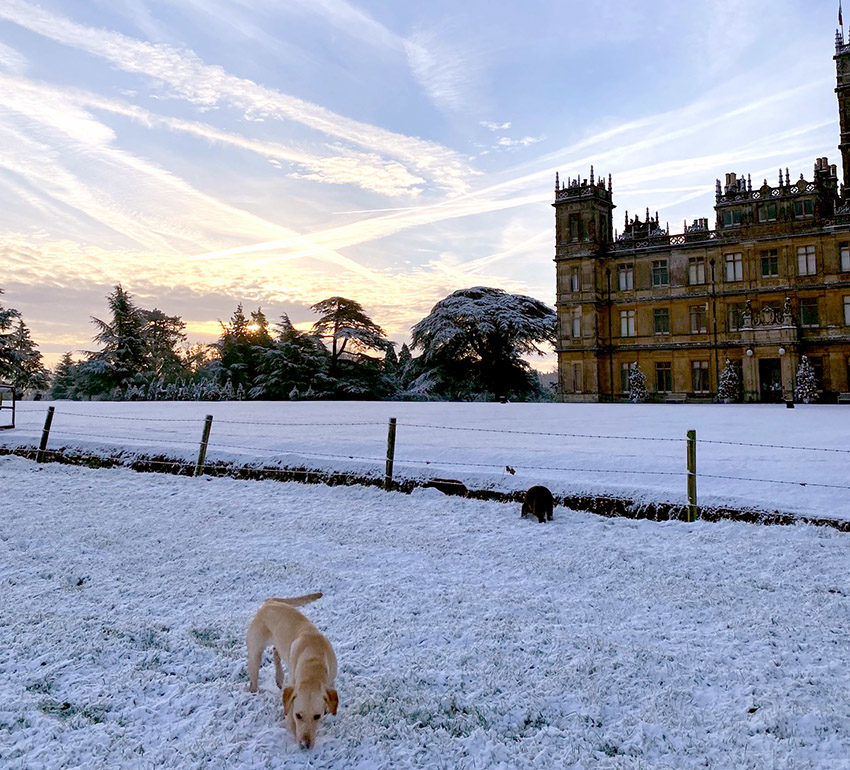
 December 6th is the feast day of Saint Nicholas, traditionally a bringer of gifts to good children. Just like the best actors in today’s world, he has various doubles, the most famous of which is Father Christmas or Santa Claus, all with generous white beards and sleighs pulled by horses or reindeer.
December 6th is the feast day of Saint Nicholas, traditionally a bringer of gifts to good children. Just like the best actors in today’s world, he has various doubles, the most famous of which is Father Christmas or Santa Claus, all with generous white beards and sleighs pulled by horses or reindeer.
The real Saint Nicholas was born in about 280AD in Patara which at the time was Greek but which now lies in Turkey: a very different climate and heritage to Lapland. Orphaned quite young when his parents died in an epidemic, he swiftly rose through the church to became Bishop of Myra and soon became well known for his generosity to those in need, his love for children and his concern for sailors and ships. Hence, he is the patron saint of children, sailors, students, teachers, and merchants. Credited with several miracles, his feast day gradually also took on some aspects of earlier gods such as the Roman Saturn and the Norse Odin, both of whom appeared as white-bearded men with magical powers such as flight.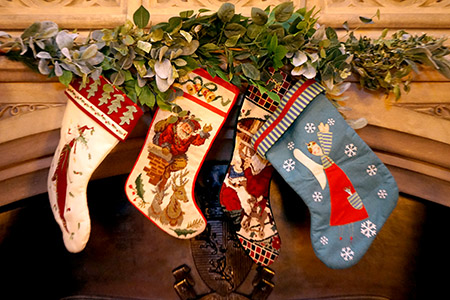
Whichever century we live in, we look for miracles and good people and around such stories we weave our own myths. Saint Nicholas still remains part of many childhoods in Europe. In Germany and Poland for example on December 5th children may receive a gift under their pillow for when they wake on the 6th, whilst Dutch children still leave out some hay for Saint Nicholas’ horse to feed on. 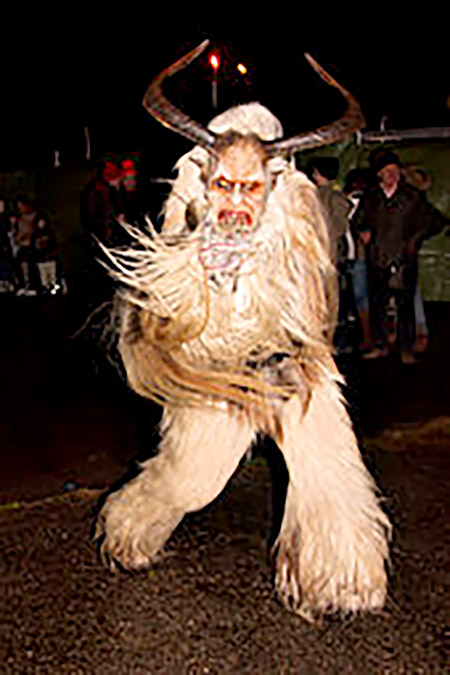
Whilst St Nicholas is still dressed like a bishop when he appears each December in Germany or Austria, he also has a companion: an ominous looking, rough, frightening character called Krampus. In some ways, Krampus very much reflects the ancient Germanic folklore used by the Grimm Brothers in their fairy tales: half-goat, half-demon. Even the name is derived from the word “krampen” meaning claw and has led to various appearances in Hollywood films.
Over the centuries, there have been various attempts to banish both Krampus and St Nicholas. Five hundred years ago, Martin Luther, the Protestant Reformer, wished to diminish the Catholic elements of Christmas and the importance of saints and introduced instead “der Heilige Christ” (das Christkindl), an angel-like Christ Child, to bring Christmas gifts. Centuries later, when the Soviet Union was formed, the communists abolished the celebration of Christmas and gift bringers.
The Presbyterians in Scotland outlawed Christmas in 1640 and the English puritans followed soon after, banning all its celebratory aspects in 1644. When Charles II returned to the throne, Christmas and all its merriments were swiftly reinstated by the King famous for his partying. 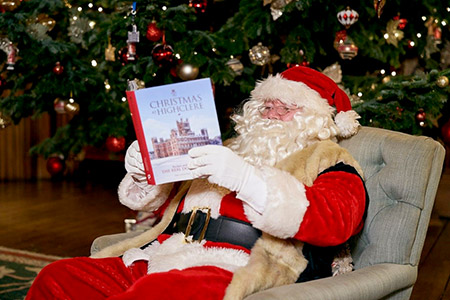
Tales of good deeds and the excuse to make merry in dark times, in Europe quite literally as it is the middle of winter, matter, as they give us hope and respite. As families and different cultures have spread and found new lands in which to settle, so traditions and stories have travelled with them; the familiar narratives helping them find anchors in times of change and chaos. What is amazing is that so many of the myths and traditions which hold us together with common values are entirely the product of human imagination. In order for them to continue, both utterance and repetition are necessary and, like Chinese whispers, they wander through time being endlessly respun for the next generation.
 Some of these retellings and evolutions can be traced quite easily, others are more gradual. One that I am particularly fond of, and which helped slip St Nicholas’s feast day towards our Christmas, is the 1822 poem Clement Clarke Moore wrote for his six children “A Visit from St Ncholas” better known today as “The Night Before Christmas. ” It has become a family tradition here and Geordie, just like his father before him, still sits down in the library on Christmas Eve to read it to my wide eyed nieces and their cousins.
Some of these retellings and evolutions can be traced quite easily, others are more gradual. One that I am particularly fond of, and which helped slip St Nicholas’s feast day towards our Christmas, is the 1822 poem Clement Clarke Moore wrote for his six children “A Visit from St Ncholas” better known today as “The Night Before Christmas. ” It has become a family tradition here and Geordie, just like his father before him, still sits down in the library on Christmas Eve to read it to my wide eyed nieces and their cousins. 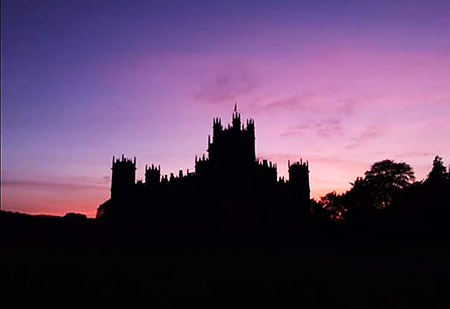
We do not get involved with Krampus at all but interestingly there is a family story that the 4th Earl had to ask six bishops to banish a rather tiresome ghost through a Yew Tree back to the Red Sea. His name was Grampus which is not so very dissimilar..








 Instagram
Instagram
Lady Carnarvon lovely pictures of Saint Nicholas and lovely Christmas and it my birthday on Boxing Day did you and lord Carnarvon have a nice weekend happy Christmas to you and lord Carnarvon
Dear Karen
I too was born on Boxing Day, so when I read your post. I thought that I should take this opportunity to wish you a very Happy Birthday for later this month.
My year of birth was followed by a leap year. Therefore, instead of having to wait 364 days for my first Christmas to arrive, I had to wait an extra day. Maybe that explains why it is my favourite time of year.
Merry Christmas to you and your loved ones.
DARLING KAREN,
HAPPY BIRTHDAY FROM BRAZIL TO YOU, STAY WELL . MY BIRTHDAY IS ON JUNE 27TH, IN BRAZILIAN WINTER, BUT AS IN BRAZIL THE WINTER IS AROUND 14 DEGREE CELSIUS, I ALWAYS DREAMED OF CELEBRATING IN SNOWY WEATHER BUT IN EUROPE IT IS NOT POSSIBLE, AS IT IS SPRING TIME. BE HAPPY, BECAUSE YOUR BIRTHDAY IS IN THE WINTER AND AFTER THE BIRTH OF JESUS.
VILLA ALEMÃ
RIO CLARO – SP
BRAZIL
Happy St Nicholas Day, I wish I was there.
Really appreciate how you wove all that history together. A great read!
I love every aspect of the Christmas season! Wishing you & yours a joyous & peaceful one.
Thank you Mi Lady for the interesting facts on St Nicholas/Santa Claus. I, too, read ‘Twas The night before Christmas to my children when they were small and they now continue the tradition of reading it to their own children. As one grows older, the true meaning of family and traditions come to the forefront and there is nothing as important as being with the ones whom you hold dear to your heart. Your tree is stunning. My husband and I had the pleasure of visiting your beautiful home a few years back…I was in awe, but Christmas seems to lend an even more magical aura to it. Thank you for sharing!
An interesting, magical story for a magical time of year.
Dear Lady Carnarvon,
A busy time, full of hope, and yes, banishing the dark aspects of Krampus within the world. My Swedish heritage has traditions of tomtens, warm mulled glogg, Lucia festivals, delicious sweets, strong coffee, family gifts on Christmas Eve and presents from Santa on Christmas Day. Traditions brought from Scandinavia and adapted in America by my immigrant grandparents. The tangible and the told, traditions continue. I love the historical background you write of, for it unfolds understanding of today’s celebrations. Thank you!!
Gorgeous photographs and Santa reading “Christmas at Highclere”- even he learns something new!
Loved the Cocktail Party and we opened another (too many to count) bottle of Highclere Castle Gin to toast you all. Our favorite gin for all seasons!
Merry Christmas and be well!
Best regards
Charlotte Merriam Cole
Thank you so much
Good Morning,
It is so nice to see the inside of you castle! If you are, to which I am a LOYAL Downton Abbey watcher, to see where all of the characters played there part, is a very warm event.
I have a question: how did ALL the rooms in the castle stay warm in the winter? Was there registers,
or did ALL the heat come from the fireplaces in each room? Enjoy your Xmas Holidays!
Forever Yours,
John Roberts
Tonawanda, N.Y. U.S.A
We wear warm clothes!
Wow this is amazing information! Thank you Lady Carnarvon, i am currently leading a tour group through No. Carolina and spending a Christmas evening at the Biltmore Estates in Asheville tomorrow night. I am going to share your story with the group! See you next year when I bring a group to see you on Sept 10th.
See you then Magic of the Movies!!
Beautiful room. I would love to browse through those books! Beautiful tree. Is it a real tree? Merry Christmas to all…
Thank you for sharing this history. While we continue in some of the traditional Saint Nicholas traditions, we should be reminded the best gift we have received and cause for celebration is salvation through Jesus Christ!
Truly love learning the history of this day; thank you so much for sharing! xo
We also have continued the tradition of reading Clement Moore’s book “Twas the night before Christmas” such a sweet tale/poem. I enjoyed your history of St. Nicholas.
A very happy Christmas to you and yours at Highclere.
And to you too!
Dear Lady Carnarvon,
thank you for sharing your lovely photos of the Castle. It looks magical in the snow, and the library looks very warm and inviting. Santa looks very comfortable, so please make sure he doesn’t get too comfy, as I think he is expected in rather a lot of places very soon! The feast of St Nicholas really gets the Christmas season underway, and all the comfort and joy that it brings.
Merry Christmas to you and to Lord Carnarvon, your family, and to everyone here today. May you all have a safe and happy Christmas with the ones you love.
Jane Bentley
Santa does look a little too comfy – just checking all his facts I think..
Lady Carnarvon lovely of Saint Nicholas and Lovely Christmas shopping did you and lord Carnarvon have a lovely weekend and happy to you and lord Carnarvon
I lovely Christmas it is my birthday on Boxing Day
Dear Lady Carnarvon, thank you for taking the time to write the blogs. I’m sure you have a hectic schedule. I look forward to seeing them pop up in my inbox and know I can sit for a few minutes and enjoy a pleasant read.
thank you so much
Thanks for this. I love it. I’m in Louisiana, U.S. My neighbor is Swiss-German, moving here a couple of decades ago. I’ve visited his family home in Switzerland. I was told of Krampus and how he would visit homes / children in hopes of scaring them into being GOOD. Again, thank you, and Happy Christmas from “the South.”
I am not sure we have hugely changed – sadly still need to be chased to do the right thing!!!
Dear Lady Fiona
A lovely Blog.
What a lovely time of the year. But the year has indeed been a long one for Us All. Not to dwell on it
but thoughts of the better days to come keeps us all going and hoping that Normalcy will return.
Dear Lady Carnarvon,
Thank you for sharing those wonderful stories. It was a delight to read.
Wishing you the very best for the holidays.
Linda
Cape May, NJ
Lady Carnarvon,
What a fun bit of history and legend you bring to us this morning – especially about the 4th Earl! May your family and friends enjoy the Holy Season, as you do bring smiles and happiness to your many readers. May the coming times be filled with more love and kindness, like that of St. Nicholas. Happy Christmas!
Martha
Lovely. I really enjoyed the retelling of St. Nick. European history is fantastic! Here in the States, we don’t have such a rich heritage. Thank you.
Dear Susan,
Seasons Greetings from Australia.
Believe it or not, your country actually played an important part in the transformation of the traditional Saint Nicholas into the modern day Santa Claus.
During the 17th Century, Dutch colonists to New Amsterdam (ie New York City) brought with them their traditions including Saint Nicholas (“Sinterklaas”).
Those traditions were adopted by the English-speaking majority under the name ‘Santa Claus’, and his legend of a kindly old man was united with the old Nordic and German (think, ‘Brothers Grimm’) folktales of a magician who punished naughty children and rewarded good children with presents. The resulting image of Santa Claus in the United States crystallized in the 19th century, and he has remained as the gift giver of presents at Christmas.
So you see, your country actually does have a rich history (& it played a most important role) in the development/history of Santa Claus.
Merry Christmas.
Wonderful story. Thank you for sharing it. Merry Christmas to you all. Xxx
Dear Lady Carnarvon,
this made me so happy and put a smile on my face. I come from Czech Republic and I agree with everything you wrote. It is so lovely that you know and write about it. The whole Europe celebrate this kind Saint. And yes, we celebrate St. Nicholas on 5/6.12, the day he died.
The Saint Nick comes to children accompanied with the angel and the devil. they represent to good and bad in life(reality). It’s not to terrify children but to reward for good deed(angel) and realised the bad ones( devil). I absolutely adored it as a kid and was always looking forward to St. Nicholas day. That’s when you get your stocking filled up with goodies ; ). The Christmas gifts are brought by a baby Jesus.. yeah catholic tradition.
It’s very nice of you to recognise this, not so English tradition.
Happy Christmas ; )
Dear Lady Carnarvon:
Thank you for making my Mondays brighter! Your blogs are so thoughtful & I always learn something! I adore the last photo of Highclere in silhouette. Just gorgeous.
Happy Christmas!
Donna Guy
Chicagoland, USA
You are so kind – thank you!
Hello Lady Carnarvon.
I did not know that and thank you for sharing.
Hope John did not get too comfortable in the chair.
Anyway, he needed a change of footwear.
Just unrolled my Christmas tapestry to roll it in reverse so it hangs better.
Try and think of Pearl Harbour at 8am tomorrow.
Carry on caroling.
Dear Lady Carnarvon,
Thank you for sharing the history of the Feast of St. Nicholas. Here, we are watching the adventures of Elf on the Shelf. My grandson’s elf, Trophy, decided to go to the airport and try to fly a plane! (My son is an airline pilot and took the pictures). Within all of the many traditions, I hope that we most remember the Savior of the world. Hope you had a lovely feast day.
Lady Carnarvon,
What lovely regaling’s of times gone by. It’s ever so true how many types, styles, beliefs and wonderful memories this Special time has for each of us. When the cold, long, grey sky’s of Winter take over- we can at least look forward to the glowing lights and beautiful colors that dance in the eyes of children- even for this moment.
Thank you for sharing the ‘beginning’ of St. Nicholas, and the photos of your decorations are always a treat!
We wish you a Joyful Noel, and hope you and your ‘St. Nick’ have a Blest
Holiday.
Regards, Jane Hrabak
Holiday Greetings Lady Carnarvon,
Thank you again for your informative and lovely photographic blog. History is a favorite of mine which is why I am such a fan of Highclere Castle. Hope you found a gift under your pillow or tree this morning! Happy Christmas to you and your families, prayers going forward that all remain well given these challenging times.
Very interesting, thank you for sharing. We had a Krampus parade in Bloomington Indiana this past Saturday. Very entertaining!
Good thank you!!
Hello Patrick and Lady Carnarvon
I hope all is well.
Thank you Lady Carnarvon for your informative, beautifully presented blogs.
Can I ask, what was/is Krampus’s purpose at Christmas time – such an ominous figure.
Kindly
Susan Marie
There is a continuous challenge of good and evil
Dear Lady Carnarvon,
Thank you for yet another informative history lesson!
Happy St. Nicholas Day to you!
Every Christmas Eve- T’was the Night Before Christmas is read in our house as well!!
God Bless you!
Iris
Lakeside, Montana
It is snowing as I write!
Dear Lady Carnarvon.
I have read that Saint Nicholas’s tomb was raided by Italian sailors/pirates and his remains were taken to Bari on the east coast of Italy.
Since 1087, the bulk of Saint Nicholas’s remains have been kept in a marble crypt in the Basilica di San Nicola, in Bari. But as with many saints, parts of the remains have been acquired by churches around the world as objects of devotion, or holy relics.
During 2017, scientists from Oxford University carbon dated bone that was said to have been from the pelvis of Saint Nicholas. While not providing proof that it was definitely from the saint, the bone (holy relic)was confirmed as authentically being from that era. It was consistent with the Saint’s death on 6th December 343AD.
Moving forward to the current time, I still have the honour of reading “The Night Before Christmas” to my family on Christmas Eve. And I look forward to doing so each year.
Seasons greetings and best wishes to all.
Yours faithfully,
Jeffery Sewell
Thank you Jeffrey
Lovely as always. I look forward every Monday to your posts. May you and your family and all those you hold dear have the most blessed and joyous Christmas.
From Las Vegas Nevada where I can only dream of a white Christmas.
MY DEAR LADY CARNARVON,
GOOD EVENING MILADY,
A POPULAR BRAZILIAN PROVERB SAY :”THE BEST THING ABOUT A PARTY IS TO WAIT FOR IT. ”
I SEE THIS COCKTAIL PARTY LAST FRIDAY, MILADY IS ABSOLUTELY STUNNING. CONGRATULATIONS FOR THE BUTLER LUIS COELHO, AND A EARL CARNARVON, BARNEY IS LOVELY.
MERRY, HAPPY, LOVELY CHRISTMAS FOR YOU AND YOURS , ALL STAFF OF THE CASTLE HIGHCLERE , AND BE WELL.
VILLA ALEMÃ
RIO CLARO – SP
BRAZIL
Thank you so much!
Thank you! This story is so interesting!!! Happy St Nicholas Day and Merry Christmas!!!
Debbie Carlsen
Plano, Texas
Dear Lady Carnarvon
Beautiful photographs of Highclere, the snow, Christmas trees and Santa looking very comfortable decked out in his finest costume of red and white all of which makes me wish I could be there and see it all in person.
Christmas for me is the celebration of Christ and his love of all of us. Church on Christmas Day, singing Carols and feasting is part of celebrating, together with the company of family and friends and being thankful for all the blessings we have.
I hope all of our chatters have a wonderful Christmas wherever they live and I wish you and Lord Carnarvon and your family a very Happy Christmas with many more to follow.
Joy Roebig
Australia
Thank you so much for this history of an ubiquitous Christmas tradition. I will share with the children I teach.
I so appreciate your taking time to write this blog. And thank you for sharing photos of the Highclere in this beautiful season. I know you must have many tasks during your day. I hope and pray that you, Lord and Lady Carnarvon, have a wonderful Christmas and New Year.
You are very kind!
I appreciate all of your blogs, as they make me feel like I am there at Highclere Castle. I want to thank you for your informative story about Saint Nicholas. I have always wondered the true story of Santa Claus. Possibly the next blog you will post is when and why the tradition of the Christmas tree.
Please don’t stop blogging, as I enjoy everyone of them!⛄☃️❄
Thank you!
Love singing Britten’s Saint Nicholas. Tells the story of the saint…….and his miracles . Love the piece, Nicholas and the pickled boys .Have a great Christmas.
Jenny Battershill.
I loved this post!
Dear Lady Carnarvon you brought the gift of this wonderful story to this (hopefully) good “child”. I learned so much that I didn’t know.
Thank you
Dear Lady C… what great storytelling and as always a joy to read. There is real talent in storytelling and you convey it so well. I can imagine Lord C seated in front of the younger family and reading that story from time immemorial stirring the imagination to a most exciting time of the year.I have fantastic memories of working at `Highclere and especially at Christmas, hauling the great Christmas Tree into place and subsequent decor expertly directed by Sally, …who else! That line of smaller trees lining the way from reception to castle is so magical and welcomes one and all to the warmest of welcomes. Thank you for your stories and podcasts and wish you and of course “Santa” and very peaceful and happy Christmas
Happy Christmas to you too Pat
Thank you for sharing the story of St. Nicholas, the bishop of Myra, now in Turkey. My husband and I visited the area several years ago. We were told that among his kindnesses was the beginning of Christmas stockings. St. Nicholas overheard some women lamenting the fact that they had no stockings. Soon women discovered a gift of stockings on their doorsteps from an unknown source, which was lated found to be the bishop, St. Nicholas.
I loved this! I read it to my husband tonight as we sat and watched our Christmas lights.
Thank you!
Thank you for this Christmas reminder of which I learnt new facts too. I do hope you and your family have a peaceful Christmas and New Year x
Lady Carnarvon,
The story of saint Nicholas fascinates me. So important to keep the Christmas traditions and our pledges to the saints, they are examples of our own life.
What a wonderful story. Thank you so much for sharing with all of us.
Merry Christmas!
What a beautifully-written Christmas story. It is a delight to read your various blogs. You are quite fortunate to have such a marvelous and wonderful setting for all seasons of the year, especially Christmas. I look forward to visiting the castle one day. In the meantime, Merry Christmas to your and your family, and many wishes for a great New Year!
Happy Christmas!
Dear Lady Carnarvon,
A bit of research this week, inspired by my elder daughter, Belinda, has revealed that the bones of St. Nicholas secrete a sweet liquid, called manna, that is supposed to have healing powers. This legend of the manna of St. Nicholas started in the 4th century in the town of Myra in modern-day Turkey.
After being taken from Myra in 1087, St. Nicholas’ bones continued to leak the sweet-smelling liquid in Bari. There are many theories about how the manna forms in St. Nicholas tomb, including the capillary action of ground or seawater and condensation in the tomb.
Since 1980, the manna is harvested from the bottom of the tomb on May 9th, which is the “Feast of the Translation of Saint Nicholas from Myra to Bari”. The manna is mixed with holy water and then put into small glass bottles decorated with pictures of St. Nicholas, and sold to pilgrims. The ‘pure santa manna’ is consumed as a drink or sprinkled on the body part that is in pain, injured or suffering from an illness.
When his tomb was opened in the 1950’s for repairs, St. Nicholas’ bones were found scattered in an inch of water and the marrow spaces were water-logged.
Between 1954 and 1957, the authenticity that this liquid truly came from the bones of the Saint, as was commonly held, was put into question. In 1954, because of the renovation being done in the crypt, the tomb was opened and the bones were exhumed. Then they were placed inside an urn, where it remained exposed to the public to see and venerate for three years in the hall of the treasures (of the Saint in the Basilica). Sometimes it was observed that the bones “perspired” a certain kind of fluid; one time the linen sheet which held the relics was found to be soaking wet when the mortal remains of St. Nicholas were re-interred in the tomb. That linen cloth has been preserved.
From 1980 onwards the manna has been formally extracted every May 9th, being the “Feast of the Translation” (of the relics from Myra to Bari), by the Rector of the Basilica, in the presence of the delegate of the Pope, the Archbishop of Bari, an Orthodox Bishop, Civil Authorities, the Clergy and Faithful, after the solemn celebration of the Eucharist. The Bishop gives the blessing and then so too does the Orthodox Bishop, with the crystal vial containing the freshly extracted precious liquid, artistically handpainted and is called “glass of St. Nicholas.” The annual output of pure “santa manna” is no more than about 50 ml.
Here is a link to film of the 2012 extraction of the manna:
https://youtu.be/YlN4q3UKhjU
During the documentary “The Real Face of Santa” (2004), forensic scientist Franco Introna put a camera into St. Nicholas’ tomb and discovered that his bones had deteriorated even more since the tomb-opening in the 1950’s because they were still immersed in water.
I was not previously aware of that phenomena, but I find it fascinating. I though you might be interested too.
Regards,
Jeffery Sewell
MY DARLING LADY FIONA,
GOOD EVENING,
I JUST READ : “SNOBS” , THE NEW BOOK BY SIR JULIAN FELLOWES, LOVED IT ,NEEDS TO BE FILMED.
CHEERS, FROM BRAZIL MILADY.
VILLA ALEMÃ
RIO CLARO – SP
BRAZIL
Dear Lady Carnarvon:
You brighten all my Mondays!! I so enjoyed reading this post as I knew nothing about the original St. Nicholas and his history–thank you.
For me Highclere represents so many joyous things, not least of which is its noble history.
The thought of Geordie reading “The Night Before Christmas” to the next generation, as his father did before him, is such a wonderful and comforting tradition. I will think of this with great joy on Christmas Eve.
God bless Julian Fellowes for choosing Highclere as his Downton Abbey! We have all been given the great gift of not only seeing the incredible beauty of the interior but also having the opportunity to know it so much better through you!! I am so grateful that you started this blog. Reading it has been a bright spot in a time of darkness. Thank you. Happy Christmas!
Thank you Nancy!
Dear Lady Carnarvon:
Thank you for your Monday blog.
Even though the e-mail arrived in a timely manner, I was unable to bring myself to compose anything cheerful in reply given the tragic event that had occurred in Oxford, Michigan.
Until next time, may Saint Nicholas watch over us all.
Perpetua Crawford
It was and is so sad – too much senselessness